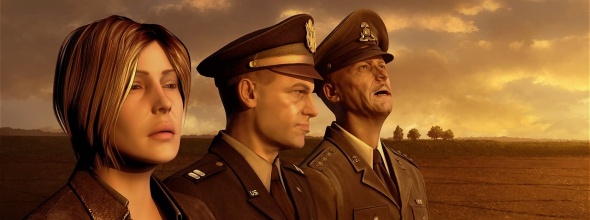Our Verdict
Compelling, slick, handsome. The predictable campaign and so-so skirmish AI are mere flesh wounds.
PC Gamer's got your back
Thanks to the killjoys behind the Hague and Geneva Conventions it's now illegal to win a war by inviting your enemies to sham peace talks then feeding them poisoned danishes. You can't disguise your tanks as ambulances. Soldiers can't even use fake arms to pretend to surrender any more. All the furtive fun has been stripped from warfare.
Well, almost all. The noble art of misdirecting a foe with mock attacks and bogus buildings, intercepting and decrypting communications, that's all still legal, and it's such shenanigans that are celebrated in this surprisingly fresh, unfailingly entertaining WWII RTS.
Doing something novel with one of strategy gaming's hoariest themes is a tall order, but Eugen have managed it. In addition to the titular ruses (more on which later) the Parisians blow the cobwebs away with truly massive battlefields. Rolling your mousewheel backwards in this game is like snagging your braces on a V2 rocket. One minute you're down on the deck amongst ravishing villages, pastures and woods, the next you're up in the stratosphere viewing entire regions through a veil of wispy cirrus.
Ruse needs the extraordinarily elastic Iriszoom engine because... um... Actually, I'm not sure it needs it at all. Observing battles from church-tower height is lovely but entirely impractical. Most of the time you'll hover a few thousand feet higher at a level where you can take in all forces, factories and supply dumps in a single glance.
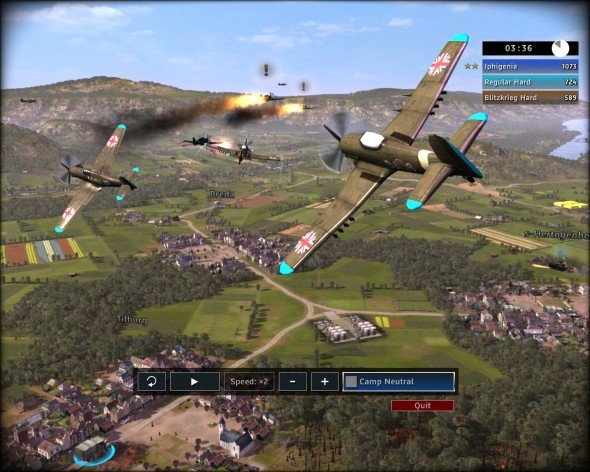
Supply dumps are the tributaries that keep Ruse's rivers of blood flowing and growing. Scattered across every map, once secured they periodically pump out the truck convoys that transport cash to your HQ. That cash can be frittered away on factories, research projects and units. Just as in 1944 Allied forces financed their push across Normandy by grabbing the piles of money that dotted the French countryside, so it is in-game.
This pillage-to-progress mechanic might be better suited to a Genghis Khan RTS than a WWII one, but it captivates all the same. Skirmishes for supply dumps give shape to the fighting. A minute doesn't pass when you're not eyeing the next dump down the road or across the river. There's a constant tension between protecting possessions you've already built, and nabbing the means to construct more. I've got $50 in the bank – do I spend it on a flak gun and an MG nest to guard my newly built tank plant, or splash it on occupying a new supply source knowing that that will mean my screen of sentinels is spread even thinner?
$50 would also buy the paratroop squads or light tanks needed to interdict my enemy's northern supply line. It would research the next rung on the armour ladder, or pay for a secondary HQ up by that windmill (thus cutting travelling times for my supply convoys). The delicious dilemmas in Ruse rarely have just two horns.
Following orders
With so many tactical temptations, it's a mercy that Eugen have made the business of orchestrating an offensive and mounting a defence so bally simple. Unit stances, order types, ammo, repairs, minelaying... anything with even a hint of fussiness to it has been ruthlessly ripped out of the trad WWII RTS formula. Grab your units and tell them where to go, that's the rude Ruse way. It's a testament to the impressive array of units (six factions each with around 30 units) and interesting approach to terrain that the simplicity never feels simplistic.
Nestling like shell-shocked leverets among the horde of historical absurdities are some pleasing tactical half-truths. Stick a mob of infantry and AT guns in a crucial forest and it's Hurtgen all over again. Put them in a town and it's Ortona. Ruse could just as aptly have been called Ambush or Boo! Bushwacht Am Rhein.
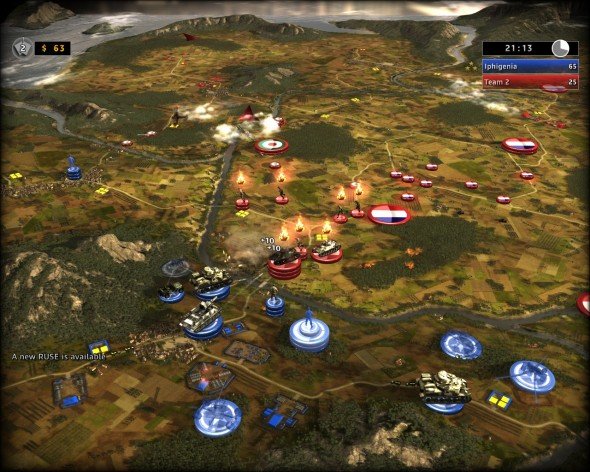
Because stationary defenders in woody or bricky areas are virtually invisible and super-deadly, and tanks can only penetrate such locales along narrow dangerous roads, probing becomes a perilous business. Advancing without sufficient artillery and bombers to pummel likely hiding places, and recon to expose lurking threats, is asking for a very bloody nose.
If there's anything more satisfying than watching a knot of friendly ambushers zooking a column of incautious panzers, it's seeing an enemy scramble to meet to an attack comprised entirely of incorporeal decoy units. Weirdly for a game about WWII operational warfare, by default every military entity is visible at all times to all players (albeit in the case of units, in the form of generic light/heavy/aircraft counters). It seems like an insane piece of design until you see the effects ruses and line-of-sight have on this naked battlefield.
Smoke and mirrors
Just because you can see exactly where your opponent's structures and forces are, doesn't mean you can trust what you see. Every couple of minutes, players get a token that can be traded for one of ten ruse types. Sector-specific (every map is chunked into arbitrary areas), these battle-turning tricks include measures that temporarily expose enemy orders (Decryption), hide forces (Radio Silence), erect fake buildings (Decoy Structure) or disguise real ones (Camo Net). You can identify enemy counters (Spy) or switch the appearance of your own from light to heavy (Revert Intel). There's a myriad ways of pulling wool over watching eyes.
The ruses work a treat, it's just a shame some aren't that rusey. Two of the most useful – Blitzkrieg (speeds troops and supply/construction vehicles) and Fanaticism (prevents the retreats that alarmed units automatically perform) – are about as duplicitous as Desmond Tutu.
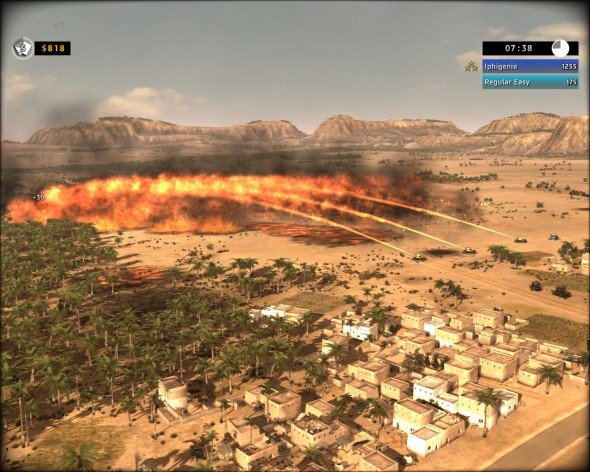
Underhand or overhand, the AI uses ruses to good effect. What it's less competent at is dealing with the brutally effective ambushes mentioned earlier. In skirmish mode, even with the dial turned up to 'hard' you can win fairly comfortably simply by huddling defences in and around protective terrain and waiting for the enemy to mosey into your meatgrinder. He may try alternate routes and bring up the big guns and bombers, but you should still come out on top.
For a stiff singleplayer challenge, play against a team of foes. Mix up the nations and profiles (the AI comes in six different personae including turtler, blitzkrieg, and air force fiend), and suddenly waiting like a trapdoor spider in woods and piazzas is a far less effective tactic.
War story
A 'hard' campaign should also stretch all but the most able. At medium difficulty there were several occasions when relentless opposition or a tight timetable forced me to restart and rethink a mission. Sturdy rather than startling, the 23-episode story takes in all the obvious Western Front hotspots, before wandering off into daft nucleartinged fantasy. Your companions on this route-march are four of the least credible/likeable WWII brass hats you could ever wish to meet. Note to games industry: writing WWII dialogue? Go watch some John Mills war movies or [gasp] try reading some period memoirs.
One suspects Eugen would brush off criticism of the singleplayer content by bringing up multiplayer. They'd have a point. Buying Ruse solely for solo play would be like buying Blenheim Palace and living in the cellar. The game has everything – except perhaps a map editor and a panoply of play modes – necessary to woo the companycraving strategician. Superbly balanced over the course of a lengthy public beta, it's pleasingly resistant to rushes and liberally sprinkled with the kind of 'little victories' that make defeats palatable. Once you learn to take a few simple precautions against students of Student (establisher of Germany's paratrooper force – Military Ed) and get the hang of mounting those powerful ambushes, gaining a foothold against even an experienced player isn't hard.
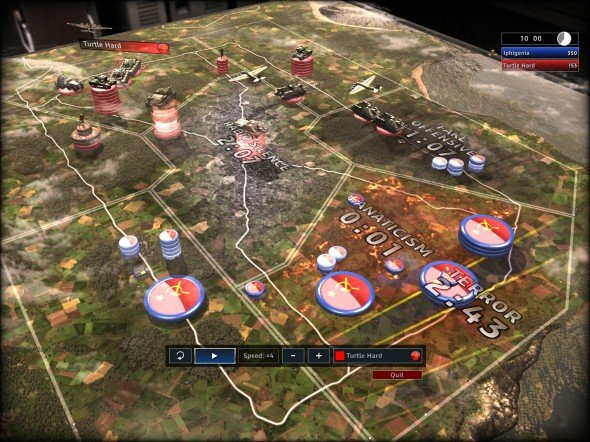
Though the campaign admits one only, two of the grandiosely titled 'operations' (historically-inspired standalone scenarios) can be enjoyed cooperatively as can any of the larger skirmishes. As an old wargamer I would like to have seen some economy-free game styles in which victory locations rather than unit kills dictated victory. I also found myself picturing a play mode in which orders are rationed on a per minute basis. Though there's plenty of room for cunning, and units do, to a large extent, look after themselves, Ruse remains a game where the nimblest mouser has a big advantage.
Normally, this would be the point in a Ubisoft review where I raged about the draconian DRM. Not this time, as the publishers have had an eleventh-hour Damascene rethink. There's now nothing – besides a fear of being outfoxed – to stop you enjoying this accomplished addition to the Sherman-shuffling genre.
Tim Stone
Compelling, slick, handsome. The predictable campaign and so-so skirmish AI are mere flesh wounds.
PC Gamer is the global authority on PC games—starting in 1993 with the magazine, and then in 2010 with this website you're currently reading. We have writers across the US, Canada, UK and Australia, who you can read about here.
